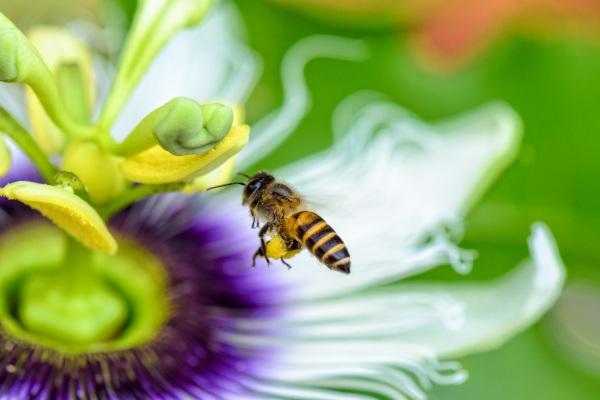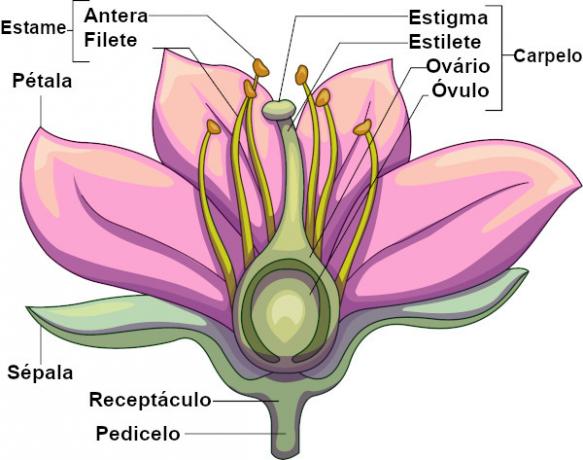The flower is an exclusive structure of the angiosperms. They can be defined as highly modified branches that have the function of ensuring the reproduction of the plant. In addition to producing the gametes, the flowers have structures that guarantee the attraction of pollinators. Colored petals and the presence of nectar, for example, cause certain species of animals visit them and ensure cross-pollination.
Read more: Pteridophytes - plants that have sap conducting holes and no seed
Mind Map: Flower

*To download the mind map in PDF, Click here!
What is the flower?
The flor is a highly modified branch present exclusively in angiosperms and that presents structures in which the male and female gametes of the plant are produced.
The flowers guarantee the attraction of pollinators, compensating for the lack of mobility of the plant and ensuring cross-pollination, that is, that the pollen of an individual is taken to the female part of another individual of the same species, promoting greater genetic variability
. Among the characteristics of flowers that promote the attraction of pollinators, we can mention the large amount of nectar of some species and the color of the petals of others.
However, it is worth noting that not all attract pollinating animals, like the flowers of plants pollinated by wind and Water. Although they do not attract animals, they are highly specialized and also allow for cross-pollination. Wind-pollinated plants, for example, release large amounts of non-adherent pollen and have well-developed stigmas.
Do not stop now... There's more after the advertising ;)
flower parts
The flowers can have up to four floral whorls, being two protective and two fertile. The protective whorls (sterile parts) are the sepals and petals, while the fertile (reproductive) whorls are the stamens and carpels.
We consider a flower as complete when the four whorls are present and incomplete when one or more of them are absent. The floral whorls are inserted in the receptacle, and the flowers are supported by a stem called pedicel.
Learn more about the floral whorls below:
- sepals: are sterile leaves that, in general, have a green color. Its function is to ensure the protection of the other parts of the flower in the flower bud. The set of sepals forms a Cup.
- petals: they are sterile leaves that are usually showy, having different colors. The petals are responsible for ensuring the attraction of pollinators. The set of petals is called a corolla. The chalice and the corolla together form the call perianth.

- Stamens: they are male fertile leaves. They have a stem called a fillet, which has, at its end, the anther, which contains the pollen sacs, in which the pollen is produced. Between the fillet and the anther is the connective, which is usually barely noticeable. In some flowers, the fillet is absent and the stamen is called sessile. The set of stamens is called androce.
- Carpels: it is the female fertile leaves that carry the eggs. The flower can have one or more carpels, which can be fused or individualized. The individual carpel or the set of fused carpels is called pistil. It is worth noting that pistil is the name given to the morphological unit, while carpel refers to the functional unit. The set of pistils forms the gyneceous. Carpels can be differentiated into three parts: stigma, stylet and ovary — in the stigma the pollen is deposited, through the stylet the pollen tube grows, and in the ovary are the eggs. When the carpels are fused, we check for the presence of chambers that contain the eggs, called locules. It is worth noting that the fruits are formed by the development of the ovary and that the seed it originates from the egg after fertilization has occurred.
Flowers that have stamens and carpels are called perfect, while those with only stamens or carpels are called imperfect. When they have only stamens, they are called staminate, and, when they have only carpels, they are called carpelled. Plants that have staminate and carpelled flowers in the same individual are called monoecious. When the staminate flowers are in one individual, and the carpelled ones in another, we say they are dioic.
Know more: Leaf anatomy - parts and functions of leaves
Inflorescences

In many species of angiosperms, the flowers are not isolated, presenting themselves in aggregates called inflorescences. There are different types of inflorescences, some being: a spadix, catkins, capitulum (photo), corymbo, umbel, glomerulus and fasciculus. If you want to go deeper into the topic of this topic, read: Inflorescences.
By Vanessa Sardinha dos Santos
Biology teacher
Would you like to reference this text in a school or academic work? Look:
SANTOS, Vanessa Sardinha dos. "Flower"; Brazil School. Available in: https://brasilescola.uol.com.br/biologia/flor.htm. Accessed on June 27, 2021.


